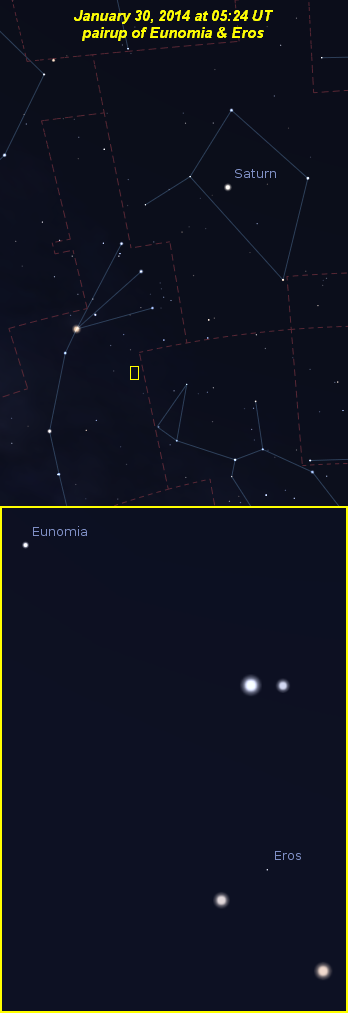¡SkyCaramba! Weekly astronomy blog for the week ending January 25, 2014
 Two asteroids are about to appear very close together in the morning sky. If you have a telescope and know where to look, you can see them.
Two asteroids are about to appear very close together in the morning sky. If you have a telescope and know where to look, you can see them.
Asteroid 433 Eros was discovered in 1898. It’s considered a near-Earth asteroid and is the first known to cross the orbit of Mars. It passed about 16 million miles (27 million kilometers) from Earth on Jan. 31, 2012.
A space probe named NEAR Shoemaker visited Eros in 1998 and 2000. The space probe wasn’t supposed to visit twice. A malfunction caused it to tumble by the asteroid in 1998. Fortunately for all interested in its mission, NEAR Shoemaker righted itself by firing thrusters thousands of times until it wasn’t tumbling anymore and could communicate with mission control on Earth.
Mission control personnel came up with a plan to get NEAR Shoemaker back on track for another Eros flyby. The probe couldn’t head straight back to the asteroid. So mission control told it to fire thrusters until the probe got into an orbit that took it by the asteroid again. It returned in 2000.
 NEAR Shoemaker took numerous pictures, magnetometer readings, and gravity measurements. Finally, it landed on the asteroid in 2001. That’s how the mission ended.
NEAR Shoemaker took numerous pictures, magnetometer readings, and gravity measurements. Finally, it landed on the asteroid in 2001. That’s how the mission ended.
Asteroid 15 Eunomia was discovered in 1851. No space probes have visited it. But if any do, scientists will learn a lot more about an entire family of asteroids named for Eunomia. There are believed to be 439 such asteroids orbiting the sun between Mars and Jupiter. They are about 5% of the asteroids in the asteroid belt.
The asteroids are grouped in families based on what they are believed to be made of. It’s possible all the asteroids in the Eunomia family were once part of the same bigger object that came apart millions or billions of years ago.
The orbits of Eros and Eunomia are very different. Eros goes around the sun in 643 days (about a year and nine months). It doesn’t get much farther from the sun than Mars and gets almost as close to the sun as Earth. Eunomia takes nearly 1,570 days (about four years and three months) to orbit. It stays in the main asteroid belt.
On January 30, 2014, Eros and Eunomia will appear very close together in the morning sky. They’ll be just 0.4° apart. Many telescopes will show them together in the same view. In the solar system’s vastness, they aren’t close. Eros will be 1.4 astronomical units away from us while Eunomia is 3.4 astronomical units away. One astronomical unit is the average distance of the earth from the sun—a little less than 93 million miles (1,490,000 km).
The best way to see them is to use a large telescope from a dark observing site. Both objects are dim. Study the sky where they are and look on several different mornings. The objects you see moving are the asteroids.
If you don’t have a large telescope or a dark enough observing site, don’t feel bad. I’ve often said half the fun in astronomy is knowing what’s happening. I hope I’ve informed you enough that you get something out of it.
¡SkyCaramba!